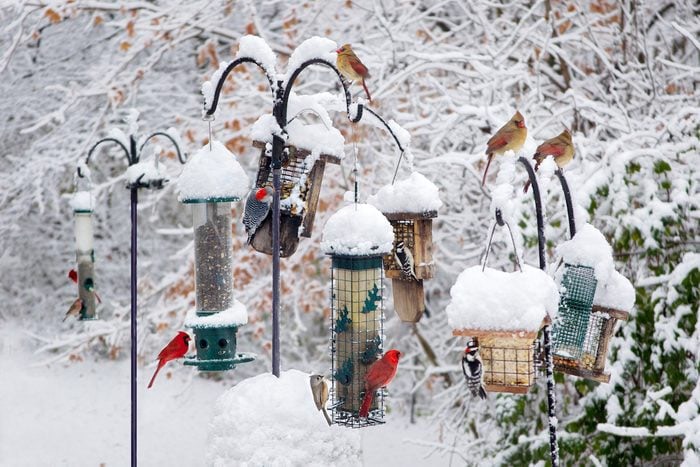

If you take a vacation and your feeders are empty for some time, the birds will abandon you.
FACT: This one of our bird feeding myths often comes to light when people prepare for trips. While it’s nice to stock up your feeders before heading out of town, don’t fret if they run empty before you return home. The birds will find plenty of food to survive without your handouts.
Rest assured, they’ll return to your feeding station soon enough, though it may take a bit for them to realize your backyard buffet is open again.
Not sure what kind of food to put in your feeders? Most backyard birds love black oil sunflower seeds.

Only woodpeckers eat suet.
FACT: While it is true that suet is a favorite of woodpeckers, they aren’t the only ones that enjoy this high-fat treat. Chickadees, nuthatches and titmice munch on suet cakes all year long. Birds that typically pass on seed in feeders may be enticed to try suet on occasion. Tanagers, bluebirds and a few warblers will nibble the blocks, especially during migration or blustery weather.
A related myth is that woodpeckers only eat suet. This is also false, as woodpeckers readily eat peanuts as well as sunflower and other seeds.
Check out 8 common questions about suet for birds.

Feeding birds prevents migration.
FACT: This is a familiar fall refrain, especially when it comes to hummingbirds. The fear is that birds will get hooked on the feeders and resist their natural instinct to migrate to wintering grounds. But it’s not true.
Migration restlessness, commonly referred to in the scientific world by the German word zugunruhe, is triggered by several factors, including hormones and day length. Instead of preventing migration, offering food gives birds a boost before their southbound journeys. Leading up to migration, they’ll fuel up on food to fill up their caloric gas tanks.

Birds only need food in winter, not water.
FACT: Visions of licking a flagpole might be responsible for a myth about avoiding winter watering, but is there any truth to this one of our common bird feeding myths? As the temperatures drop, concern about keeping birds healthy and warm picks up. Providing a heated water source gives birds easy access to open water.
In addition to food, water is essential in keeping birds healthy. They gulp up drinks without having to spend extra energy melting snow.
Though birds tend to avoid splish-splashing on the coldest days of the year, a shallower dish encourages drinking without bathing. It’s generally safe for bird to bathe even in winter, but rare cases have occurred in which wet birds have perished in extreme conditions.

Peanut butter causes birds to choke.
FACT: Like suet cakes, peanut butter is a high-fat treat that is popular bird fare, especially in winter. Beaks are mostly made up of smooth keratin similar to human fingernails, so peanut butter isn’t likely to stick to the roof of their mouth as it does for people.
It’s true that straight peanut butter can be sticky, so serve it in a way that ensures it stays off birds’ feathers. Spreadable peanut butter suets—available commercially—are usually less tacky, thanks to added peanut meal or cornmeal. These spreadable products can turn any tree into a bird feeder.

Cayenne pepper keeps squirrels away.
FACT: Sprinkling cayenne pepper in birdseed, around the base of a shepherd’s hook or along the edge of a garden may or may not deter squirrels. Some say it works, some say it doesn’t. The bigger concern is the loose pepper blowing around and getting into a bird’s (or a human’s) eyes.
However, concentrated capsaicin oils can discourage some animals from eating things. Mammals such as squirrels, raccoons and humans have taste receptors that allow them to feel the temporary burn of pepper oils. Birds’ taste receptors aren’t affected by pepper oils, though, so birds will readily eat capsaicin oil–coated seeds and suets.
If you have concerns about hot-pepper birdseed or oils, and baffling the poles isn’t an option, try serving safflower seeds, which squirrels tend to avoid.
Check out the best squirrel proof bird feeders and 12 tips that work.

Bird Feeding Myth 7
Bread is safe to feed waterfowl.
FACT: It is tempting to feed ducks and geese when they congregate at open water areas, and in certain instances it can be done safely and legally. However, despite the popularity of the practice, bread and crackers should never be fed to birds. The offerings provide little nutritional value to them and can even cause a feather deformity known as angel wing.
Better food choices for ducks and geese include cracked corn, leafy greens, and vegetables such as peas and broccoli, which more closely resemble the natural diets of the birds. It’s also important to feed in moderation as waterfowl can become aggressive, which is why it’s illegal to feed them in many park settings.
Next, discover more of the foods you should never feed to birds.
Sources:
https://www.latimes.com/opinion/op-ed/la-oe-van-hemert-migration-birds-spring-20190310-story.html
https://www.sciencedirect.com/topics/agricultural-and-biological-sciences/zugunruhe
Originally Published: December 19, 2023